Academic Symbols
Heraldic Flags
Official Colors for Degree
Academic Symbols

In 1948, the USC Board of Trustees approved an updated version of the university seal. In this version, the poppies appear next to the shield inside the outer band, which is now formatted as a scroll. The Latin motto is inscribed on a separate scroll at the base of the seal. This seal continues to be the imprimatur, or official signature, of USC to this day.

The medallion of office is worn by the president over their official regalia at ceremonial occasions. It was created by Associate Provost Jerome B. Walker for the inauguration of President James H. Zumberge on May 10, 1981 to serve as a tangible symbol of the authority vested in the president by the Board of Trustees. For his 1991 inauguration, President Steven B. Sample asked Dr. Walker to design the medallion’s current chain, which consists of shields identical to that found in the university seal, linked together 16 times.
The front of the medallion depicts the university seal in full, and the back lists the name of the current president and the date of their inauguration. Each president keeps their medallion after retirement. For his 2010 inauguration, Dr. C. L. Max Nikias directed that two copies of the medallion be created. One copy will be worn by the president at appropriate events, while the other will be displayed in the Office of the President. The displayed medallion will include the name of each of the past presidents of USC engraved on the links of its chain.
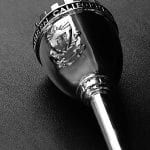
The mace of the University of Southern California is a ceremonial scepter symbolizing the authority of the Office of the President. The President of the Faculty has the honor of serving as mace bearer in all academic processions for commencements and other official university ceremonies.
Historical maces date back to the 13th century when they were first carried as ceremonial symbols of the royal authority at events attended by English kings. The university mace was first used at the inauguration of President Norman Topping on October 28, 1958.
The mace was designed and crafted by the renowned master silversmith, USC alumnus and professor emeritus Hudson Roysher. The head of the mace depicts the university seal. Encircling the head of the mace is the hand-engraved inscription, “1880 University of Southern California.” The names of USC’s past presidents and current president, Dr. Carol Folt, are engraved on the bowl. The crowning ornament is a depiction of the walled city of Troy. The mace is permanently displayed in the Office of the President.

Each marshal in the official procession carries a walnut baton, adorned with the university seal in gold at the top. The baton’s fluted design symbolizes the torch of learning, which is also featured on the university seal.
At the University of Southern California, faculty members are traditionally selected as marshals to lead the student procession during the New Student Convocation and Commencement. The University Marshal and the President of the Faculty lead the procession.
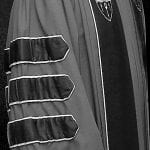
The cardinal robes of office worn by university trustees were designed by Dr. Jerome B. Walker for President Steven B. Sample’s 1991 inauguration. Reminiscent of the university’s doctoral gowns, the trustee robes feature red velvet front panels and chevrons on the sleeves. Bright gold piping outlines both the panels and the chevrons. Each of the front panels features an embroidered shield on the lapel, taken from the university seal. The trustees wear a doctoral hood lined with USC’s traditional gold satin and cardinal chevron. The hood has a red velvet collar representing the university, in place of a faculty color representing a single discipline. The University Marshal wears a special gown that serves as a bridge between the trustee robes and the university’s doctoral gown, with the university seal embroidered on the lapel.
Heraldic Flags
Originally designed by Dr. Jerome B. Walker for President James H. Zumberge’s 1981 inauguration, heraldic flags for each academic degree-granting unit are displayed at commencements and other academic convocations. These flags, carried by students, precede the faculty in the procession. By a long-standing tradition, most academic disciplines have used an identifying color, which is displayed on academic hoods to indicate the subject area in which the wearer obtained the degree. These identifying academic colors are used in the banners of the various schools and divisions of the university.
Found in the university seal, the torch of knowledge is a clear and honorable symbol, well suited to an institution of higher learning, and is one of the charges on the university’s official seal. The university seal also contains a sun. Known as a “sun in its splendor,” it has a perimeter featuring alternating straight and wavy rays. The straight rays represent the light and the wavy rays the warmth and affection that the university extends to its students and community. The torch and the sun are used to unite these disciplines under the flag of the University of Southern California.

College of Letters, Arts and Sciences
Academic colors: white for letters, gold for sciences. The wide-ranging fields over which this college functions are symbolized by the intimate intertwining of letters, arts and sciences in the heraldic pattern known as “gyronny.” The torch of knowledge serves as a reminder that the college is the academic heart of the university.
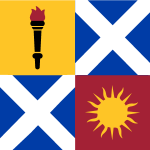
The Graduate School
Academic color: royal blue for the doctorate. In heraldry, the saltire (a corner-to-corner cross) symbolizes the very wide range of disciplines over which this school presides and which the saltire unites in one unit.

Advanced Computing
Academic color: orange. The circuit board and branching nodes of the flow chart signify the collaborative bonds that spark groundbreaking discoveries in advanced computing. The electrons orbiting the circuit board refer to quantum computing, and the gears in the Git branch nod to a tight-knit relationship with the USC Viterbi School of Engineering.
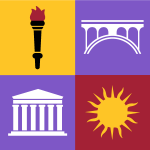
Architecture
Academic color: blue-violet. The Doric portico is used here as a symbol of beauty and pro-portions inspired by the early Greek architects, who continue to inspire the architect today. The modern bridge represents progress, connections and stability. The blue background, representing the sky, suggests the almost limitless scope of architecture.

Art and Design
Academic colors: brown for the arts, white for letters. Here the symbols reflect two important branches of art and design. The paintbrush and pencil symbolize fine arts such as painting, drawing and sculpture. The abstract symbol, with its pixel-like design, reflects the emergence and evolution of digital arts.
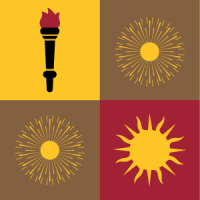
Arts, Technology and the Business of Innovation
Academic color: brown. The supernova, an astronomical event that occurs during stellar evolution causing the sudden appearance of a new, brighter star, represents the idea of disruption and the supreme energy exhibited by the founders and students of the academy. The flag’s additional colors are described in heraldic language as metals: gold and bronze.
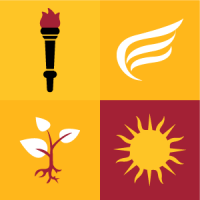
Bovard College
Academic color: white. The soaring sails symbolize confidence and agility in providing a student-centered approach to learning. The rooted plant is a symbol of the stability, growth and abundance of opportunity. Colors featured in the flag are rendered as metals—gold, silver and bronze—in traditional heraldic terms.
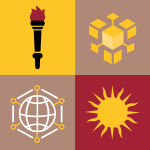
Business
Academic color: drab. The square figures that are symmetrically arranged on this flag are designed to symbolize the organizational characteristics of business in all its complexity. The interconnected sphere represents an enterprising and global approach to business.
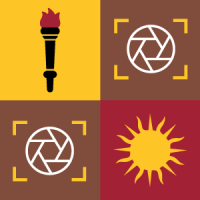
Cinematic Arts
Academic colors: brown for the arts, white for letters. The six triangles represent the strength of the individual specialties, such as camera, editing, sound, writing, criticism and aesthetics, that form the larger discipline of cinematic arts. When combined, they form an aperture, at the center of which is the human eye, representing the mediation essential to the discipline.
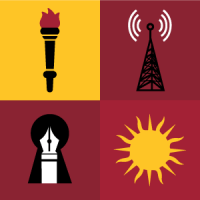
Communication and Journalism
Academic colors: crimson for communication, white for journalism. The three data waves emanating from the transmitter in both directions symbolize the fact that all communication has a threefold aspect—communicator, audience and medium—all of which are involved in the interplay and sharing of a message. The quill tip within the keyhole represents freedom of the press.

Dance
Academic color: amethyst. Dance is one of the oldest and most central expressions of humanity. The two interlocking figures represent creativity and innovation, and they capture the artistry of bodies in motion. The sun in its splendor represents the courage and power incumbent in authentic artistic creation, and white is the traditional heraldic color representing the arts and humanities.
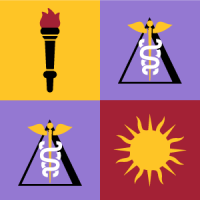
Dentistry
Academic color: lilac. Dentistry, like the other scholarly areas associated with health care, uses the traditional Asclepian staff and serpent—in this case, enclosed in a capital Greek letter, delta, an homage to the official emblem of dentistry.

Dramatic Arts
Academic colors: brown for the arts, white for letters. The classic emblem of comedy and tragedy is based on masks worn by actors in ancient Greek theater productions. They reflect not only the two main genres of the dramatic arts, but also the duality of the human experience.
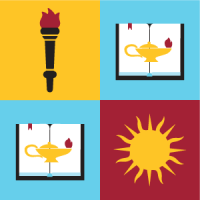
Education
Academic color: light blue. The book, illuminated by the lamp of learning, is a very widely used, traditional symbol for education, and occurs in many shields of arms. The flame from the torch of knowledge illuminates the tip of the lamp.

Engineering
Academic color: orange. The interlinked circles, inspired by the classic mathematical Borromean rings, join the cogs and gears in this flag to symbolize the way in which the profession of engineering inter-acts with math and the applied sciences to solve society’s most pressing and wicked problems.
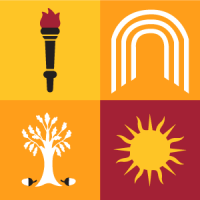
Gerontology
Academic color: white. The very characteristic architecture of this school is incorporated in the flag, along with the oak tree, symbolizing sturdiness and longevity, and acorns, representing the constant renewal of life.

Law
Academic color: purple. The four points surrounding the gavel in this flag symbolize the levels at which the legal profession provides a bulwark and framework for our society: federal, state, county and local. The scales of justice reflect the fair and impartial balance sought by the law.

Medicine
Academic color: green. The staff of Asclepius, the Greek god of medicine, around which is entwined the harmless snake beloved of Asclepius, has been the symbol of medicine for many centuries.
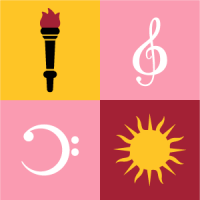
Music
Academic color, pink. Music is a universal means of communication between human beings, linking the past, present and future. The treble and bass clefs symbolize music expressed in all its forms and styles, vocal or instrumental.
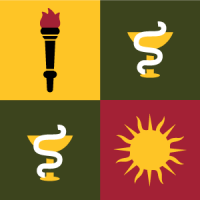
Pharmacy
Academic color: olive. Pharmacy is symbolized by the bowl of Hygeia, the Greek goddess of health, coupled with the Asclepian serpent, showing the intrinsic relationship between pharmacy and medicine.
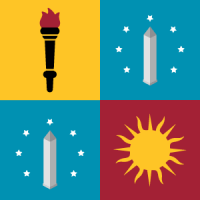
Public Policy
Academic color: peacock blue. The school’s work is represented in triads, reflecting the intersection of three sectors, three levels of government, three locations and three levels of degree programs. The three shapes that come together to form the obelisk evoke those triads. The symbol of the obelisk surrounded by stars reflects structure, security and liberty.

Social Work
Academic color: citron. As symbolized by outstretched hands cradling the globe, social work by its very nature is about embracing our connections as human beings and inspiring the spirit of compassion and mutual respect that assists individuals and communities in reaching
Official Colors for Degrees
For master’s and doctoral candidates, the silk lining of the hood bears the color or colors of the institution from which the wearer has graduated. The official colors for the University of Southern California are cardinal and gold. The color of the velvet band around the hood shows the department in which the wearer earned a degree. All Master of Arts (white) degrees and Master of Science (gold yellow) degrees are bestowed by the Graduate School.
Graduate Student Hood Colors by Program
Accounting: Drab
Architecture: Blue-Violet
Art and Design
- Master of Fine Arts: Brown
- Master of Arts: White
Arts, Technology, and the Business of Innovation: Gold
Biokinesiology and Physical Therapy: Aqua
Bovard College: White
Business Administration
- All MBA Programs: Drab
- All Master of Science: Gold
- Business for Veterans: Drab
- Management Studies: Gold
- Medical Management: Gold
- Library and Information Science: Gold
Cinematic Arts
- Arts: White
- Fine Arts: Brown
Communication
- Communication Informatics: White
- Communication Management: Crimson
- Digital Social Media: Gold
- Global Communications: White
- Public Diplomacy: Peacock Blue
- Strategic Public Relations: White
Dance: Gold
Dentistry
- Dental Surgery: Lilac
- Science: Gold
Dramatic Arts: Brown
Education: Light Blue
Engineering: Orange
Gerontology: White
The Graduate School
- Master of Arts: White
- Master of Science: Gold
- Doctor of Philosophy: Royal Blue
Journalism
- Journalism: Gold
- Specialized Journalism: White
- Specialized Journalism the Arts: White
Law: Purple
Medicine
- MD: Kelly Green
- Academic Medicine: Gold
- Physician Assistant: Olive
- Public Health: Salmon
- Science: Gold
Music: Pink
Occupational Science and Occupational Therapy
- Occupational Therapy OTD: Rhodes Blue
- Occupational Therapy: White
Pharmacy
- PharmD: Olive
- Science: Gold
Public Policy
- Policy, Planning, and Development: Crimson
- Health Administration: Peacock Blue
- International Public Policy and Management: Peacock Blue
- Leadership: Peacock Blue
- Public Administration: Peacock Blue
- Public Policy: Blue
- Planning: Crimson
- Real Estate Development: Crimson
Social Work: Citron